Introduction
In today's dynamic market, small business owners face stiff competition and the need to stand out from the crowd. One successful example is Huldit, an outdoor gear innovator that has differentiated itself by designing tailored solutions for outdoor enthusiasts. Understanding your customer base is crucial, and market research provides valuable insights to tailor your offerings and connect with your target audience.
Crafting an impactful brand and embracing strategic risks are also key to thriving in a competitive landscape. This article explores practical strategies for small business owners to overcome obstacles and achieve long-term growth and success.
Overcoming Stiff Competition
For entrepreneurs looking to establish a specialized position in today's ever-changing market, it's essential to create a competitive edge that sets their products apart from others. One such example is Huldit, an innovator in the outdoor gear industry, which has successfully differentiated itself by designing solutions tailored to the unique needs of outdoor enthusiasts. With products like the versatile Huldit U-lock holder and practical frame bag, they epitomize the essence of a strong value proposition—addressing specific problems with high-quality, easy-to-use, and durable products.
Understanding your customer base is fundamental to gaining this edge. Market research is essential, as it uncovers crucial data like demographic information, enabling you to understand the demand, market size, and economic indicators relevant to your enterprise. Armed with this knowledge, you can identify where to focus your efforts, tailor your offerings, and articulate a clear, compelling message that resonates with your target audience.
Furthermore, crafting an impactful brand goes beyond a logo or slogan. It's about fostering expectations, memories, and relationships that influence consumer choices. Being a small enterprise, your brand is your DNA, encompassing your mission, reputation, and the unique benefits you provide. This holistic approach to branding and marketing can help you create a robust identity in the marketplace, and when coupled with targeted advertising strategies—like seizing opportunities on niche websites during the holiday season—you can connect with a focused audience, driving engagement and sales.
Finally, embracing strategic risks, as demonstrated by Huldit's founder investing life savings into the launch, can align with your vision and propel your company forward. By identifying your competitive advantage and positioning your enterprise accordingly, you're not just surviving the competition but thriving within it, setting the stage for long-term growth and success.
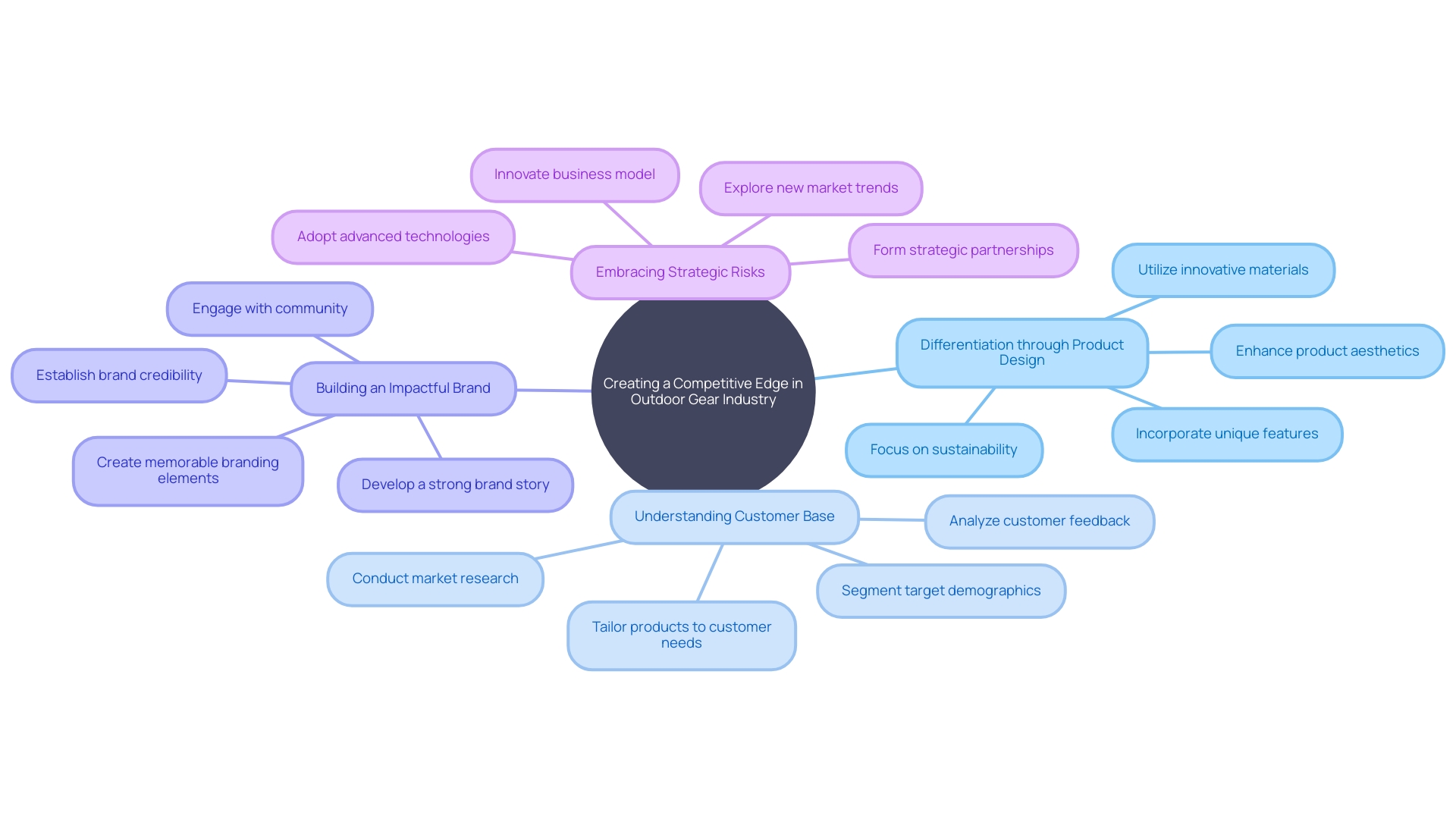
Improving Poor Visibility
Entrepreneurs face the daunting task of carving out a space in a crowded marketplace, where gaining visibility is paramount to attracting the right customers. The answer is found in a strong digital advertising approach that includes local search optimization and SEO optimization, customized to the specific requirements of enterprises. With the rise of recreational activities like golf, targeting a younger demographic that relies heavily on digital channels for information and purchases is essential. Businesses must cultivate a strong online presence, not just through websites, but by harnessing the power of social media to engage with customers and create content that resonates with their audience's preferences and behaviors. By utilizing local visibility strategies, such as optimizing for local search outcomes and directories, enterprises can enhance their presence in their community. Partnering with influencers and industry experts can further expand their reach. Using the correct strategy, even companies that are new to the online realm can flourish, harnessing digital advertising to cultivate customer connections, boost revenue, and guarantee lasting achievement.
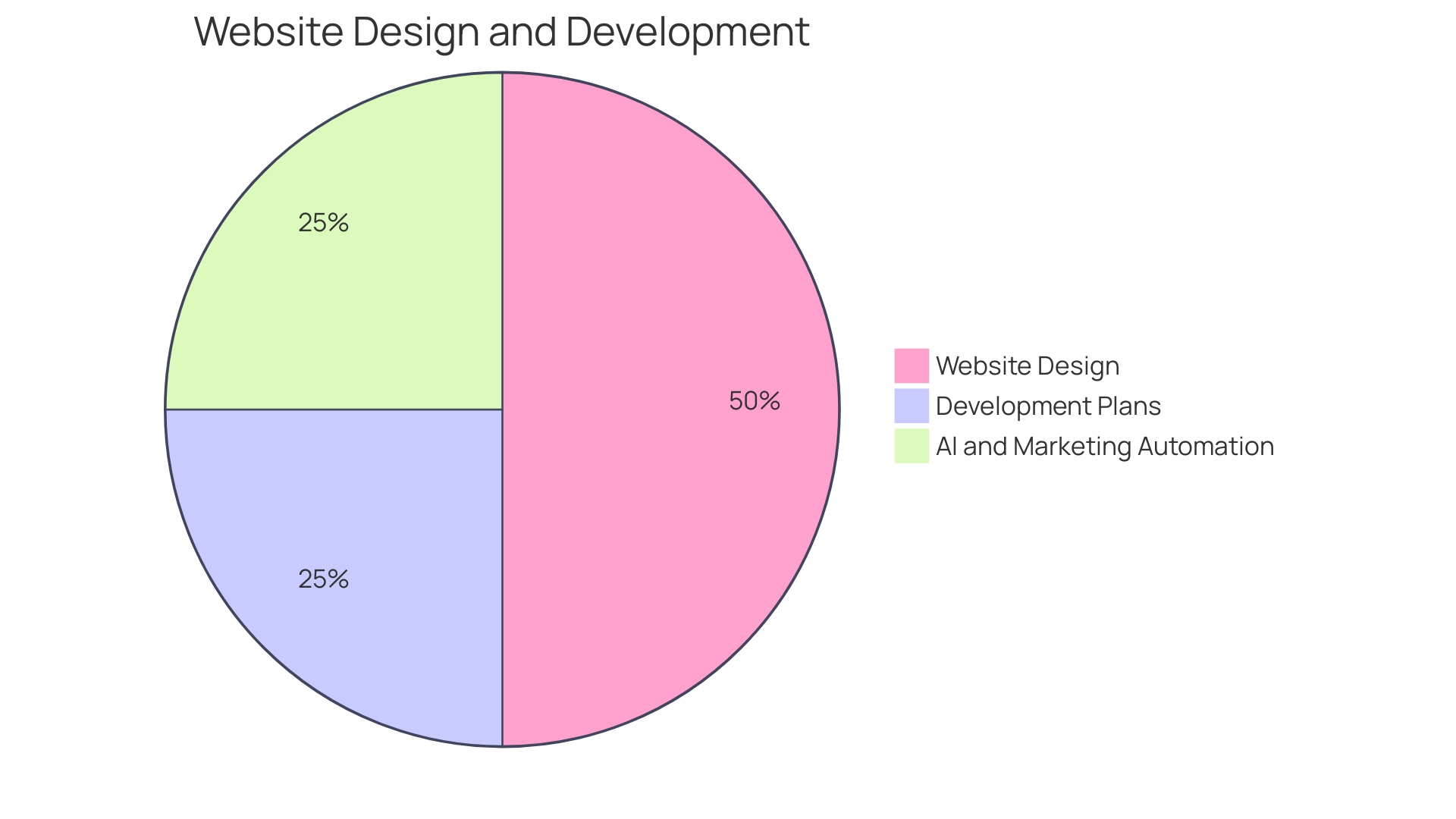
Managing Limited Financial Resources
Developing a strong budget is crucial for small enterprise owners to navigate the intricacies of entrepreneurship with limited funds. A comprehensive budget should incorporate all income sources and categorize expenses into fixed and variable groups. This distinction allows for a better understanding of essential costs such as rent and utilities versus more flexible expenses like marketing and office supplies. Moreover, it's crucial to factor in unexpected expenditures, allocate savings for future investments, and maintain an emergency fund.
To further optimize financial management, scrutinizing cash flow is imperative. Consistently monitoring the inflows and outflows of cash ensures that your company can meet its operational demands and pursue growth opportunities. Using a budget template can simplify this process, providing a structured approach to financial planning and decision-making.
When resources are scarce, exploring funding options becomes a key strategy. Loans and grants for small enterprises, including niche programs like the Small Business Innovation Research (SBIR) or Small Business Technology Transfer (STTR) programs, can provide the necessary capital to fuel research and development. It's also wise to evaluate capital needs meticulously to present a realistic valuation to potential investors or lenders.
Embracing cost-saving initiatives is another avenue to financial stability. Negotiating with suppliers, considering alternative vendors, and implementing operational efficiencies can significantly reduce expenses. Additionally, keeping abreast of regulatory changes such as adjustments to the National Living Wage and National Minimum Wage is vital to ensure compliance while managing payroll costs.
Small enterprises are the foundation of the economy, with over 33.2 million in the United States as we enter 2024. Despite the challenges, including a survival rate of only 25% beyond 15 years, effective financial planning and management can significantly increase the likelihood of long-term success.

Addressing Lack of Marketing and Branding Expertise
Entrepreneurs with limited resources who feel inundated by the intricacies of promoting and establishing their brand can draw motivation from triumphant instances and contemporary approaches within their respective field. For instance, a branded hotel in a bustling city center dramatically increased its food and beverage sales by strategically leveraging its location to attract more diners. In the same way, entrepreneurs who own smaller enterprises can enhance their approach to promoting their products or services by establishing their unique identity, just like how a well-known symbol or color combination can instantly be associated with a brand such as Coca-Cola and create specific customer anticipations and interactions.
To develop a strong brand and advertising strategy, entrepreneurs should contemplate involving advertising professionals or agencies. These experts can provide valuable insights and support, as underscored by the story of Tim Rayne, a partner at a regional law firm who built a significant practice without traditional advertising. Rather, he depended on his entrepreneurial spirit and strong work ethic, showcasing how alternative promotional tactics can produce significant outcomes.
Furthermore, considering that only a quarter of small enterprises endure beyond 15 years, it is essential to acknowledge the significance of successful promotion in guaranteeing sustainability. For example, the 'The Entrepreneurial Journey' report by Skynova indicated that 40% of entrepreneurs consider their biggest challenge to be the strategy for promoting their products or services. This underscores the significance of investing in knowledge and skills in promoting understanding and abilities through training, upskilling programs, or seeking mentorship within commercial networks to learn from those with proven success.
Finally, entrepreneurs should not underestimate the potential of grants as a source of funding. A grant writer can be influential in obtaining this kind of funding, which can then be allocated towards improving marketing efforts and strengthening the brand's identity.
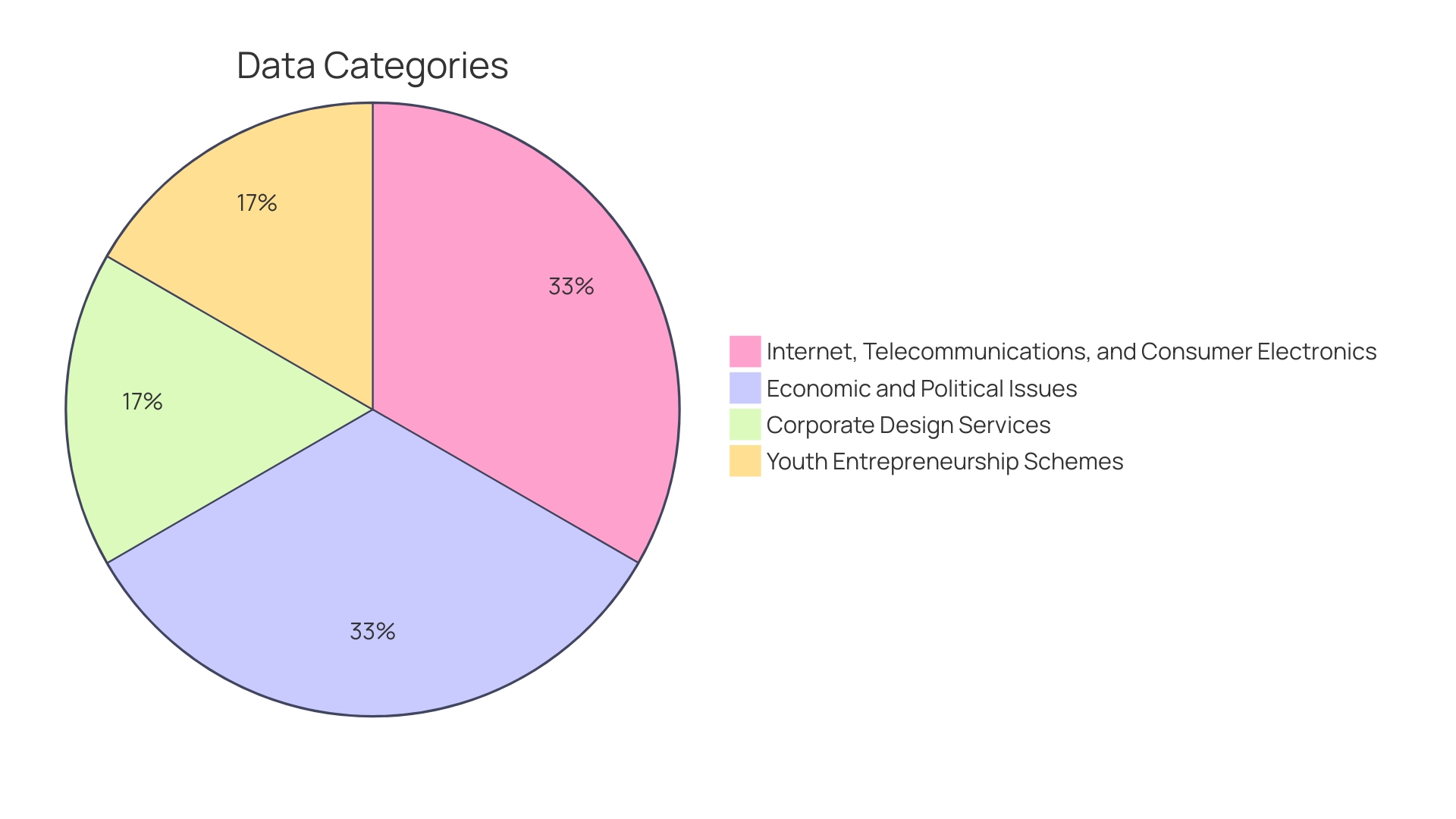
Effective Time Management
As small enterprise proprietors, it's vital to master the art of wearing multiple hats while steering the ship towards daily goals. The Pareto Principle suggests that a mere 20% of your tasks significantly impact your results. Therefore, prioritize these tasks to enhance productivity and achieve success. Allocate time blocks for critical tasks and set concrete deadlines to maintain momentum. Delegation is also key—identify tasks that may not directly contribute to company growth and consider outsourcing them to maintain focus on your core objectives. Productivity tools can help manage your team and projects efficiently, reminiscent of the success early companies achieved even before the arrival of these technologies. Furthermore, incorporating intervals and prioritizing self-care is crucial to prevent exhaustion, guaranteeing that your path as an entrepreneur is both prosperous and enduring.
- Embrace technology to automate tasks and streamline operations.
- Break down your big dreams into manageable goals, as suggested by Gino Wickman in 'Traction,' and tackle the most challenging tasks first thing in the morning.
- Maintain a 'Waiting for' list to keep track of delegated tasks and ensure accountability.
Remember, with the right approach to time management, you can transform the way you work, leading to greater control and satisfaction in your professional pursuits.

Building and Retaining a Strong Team
For small enterprise owners, building a team that is both skilled and dedicated is crucial. Reflect on the success of Tech Ladies, which evolved from a modest meetup into a flourishing community venture with 200,000 members, ultimately leading to a significant acquisition. Their growth strategy was anchored in a culture that reflected the values and persona of the founder but was adaptable enough to thrive independently.
To emulate such success, start by precisely articulating your company's culture and ethos during recruitment to attract the right talent. It's not just about offering competitive salaries; it's about providing a trajectory for professional growth and development. Take a page from companies like Tech Ladies and focus on building a community within your workforce that shares your company's vision and values.
Cultivating a workplace that promotes teamwork and open dialogue is essential. Consider the findings of Harvard's Hackman and Vidmar, who highlighted the importance of optimal team size for effective collaboration—usually no more than five members.
Moreover, the journey of Vontelle Eyewear teaches us the importance of realizing when it's time to expand your team. When the founders were overwhelmed with orders, they understood the necessity of hiring additional help to prevent burnout and sustain growth.
Embrace a 'Ruthlessly Constructive' approach in your operations, as recommended by John Udell's role at Microsoft. This involves fostering an environment where constructive criticism is welcomed and where the team works collaboratively to overcome challenges and drive the company forward.
It's a balancing act—nurturing the existing team while strategically expanding. With over 33.2 million enterprises in the United States as we head into 2024, distinguishing your company through a robust team culture is more crucial than ever. Keep in mind, only a quarter of enterprises endure beyond 15 years—concentrating on team growth and culture is not only advantageous, it's essential for long-term success.
Managing Cash Flow
Efficiently handling cash flow is not only an operational requirement but also a strategic tool for enterprises to flourish. A well-structured cash flow forecast is indispensable, acting as a financial roadmap that delineates expected incomes against outgoings. To bolster cash inflows, consider offering early payment incentives or shifting towards a subscription model for predictable revenue streams. Negotiating extended payment terms with suppliers can ease the outflow pressure, providing breathing room for financial maneuvering. A vigilant approach to the cash flow statement is essential; it's the pulse check for financial health, highlighting potential snags early on to allow for swift, preemptive action. For instance, an eCommerce store benefits from low overhead and a wide customer reach, while a consulting enterprise can capitalize on steady, client-based revenue. Both models demonstrate the importance of low operational costs and the attractiveness of recurring income, solidifying the financial foundation of the company. By adopting these strategies, enterprises can navigate the complexities of cash flow management, ensuring a strong and sustainable financial future.
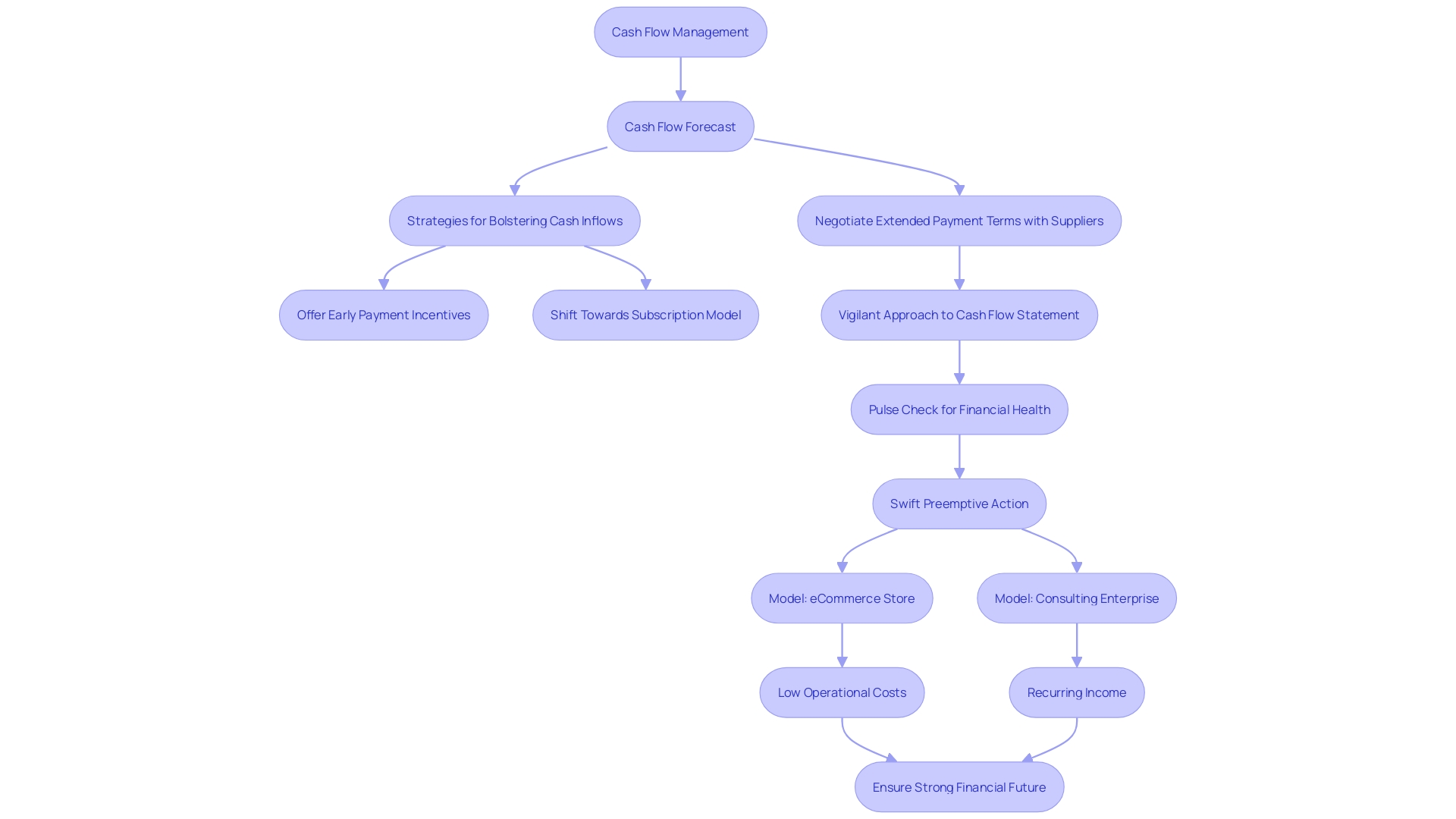
Adapting to Market Changes
For entrepreneurs, adaptability is crucial in navigating the constantly changing marketplace. By staying updated on industry movements and consumer behavior, companies can proactively identify emerging opportunities and risks. Constant vigilance over the competitive landscape ensures that your product and service offerings remain cutting-edge and aligned with market expectations. Harnessing the power of technology is non-negotiable; digital tools and platforms are instrumental in optimizing operations, broadening your reach, and facilitating swift responses to market trends.
Successful adaptation may involve reinventing your user experience, as evidenced by a case where a technical stack comprising Django, Tailwind, and HTMX significantly improved a small enterprise's customer interactions. This strategic move, coupled with a meticulous SEO overhaul focused on competitor analysis, content enhancement, and a targeted new content roadmap, led to a surge in sales and stellar customer feedback. Similarly, a major hotel leveraged its prime location to revamp its restaurant offerings, resulting in a marked uptick in food and beverage sales.
Adapting to market shifts is not just about internal changes; it involves fostering a community of collaboration. A convincing example of this community-driven approach is the establishment of an online store by a coalition of local enterprises, offering a variety of local products and catering to the discerning tastes of their mutual clientele.
Comprehending market dynamics is also crucial, as emphasized by the insights from 'How Big Things Get Done,' a book outlining the significance of thorough research and collaboration for ambitious projects. The principles of engagement and adaptability outlined in the book have been instrumental in guiding companies through transformative phases.
To effectively navigate through these intricate market landscapes, small enterprises must participate in comprehensive market research, extracting demographic insights to identify customer needs and market potential. Considering inquiries regarding demand, market size, economic indicators, and geographic reach allows organizations to develop tactics with accuracy and foresight. In fact, embracing a proactive stance on market research can substantially mitigate risks even during the early stages of a commercial endeavor.
In essence, flourishing in today's dynamic commercial environment necessitates a combination of unwavering monitoring, strategic partnerships, technology adoption, and a deep understanding of market research. Individuals who adopt these principles can position themselves to not only survive but thrive amid the challenges and opportunities that lie ahead.
Maintaining Work-Life Balance
Small enterprise proprietors regularly manage an array of responsibilities, making work-life balance appear like an elusive goal. However, it isn't just a nice concept but a necessary practice to avoid burnout—a syndrome recognized by the World Health Organization as resulting from persistent workplace stress. To achieve equilibrium, it is vital to delineate clear boundaries. Allocate specific time slots for relaxation and hobbies, just as you would for professional gatherings. Embracing flexibility can also be transformative. For example, Advanced RV's initiative of a four-day workweek prompted team members like Bill Kowalcic to innovate, streamlining processes without compromising quality. Delegation is another key strategy, empowering your team to take on responsibilities and allowing you to step back and rejuvenate. By delegating tasks, you cultivate a competent team that can maintain operations, giving you the essential time to reconnect with personal interests and family. Ultimately, integrating these approaches leads to enhanced performance and a more rewarding personal and professional life.
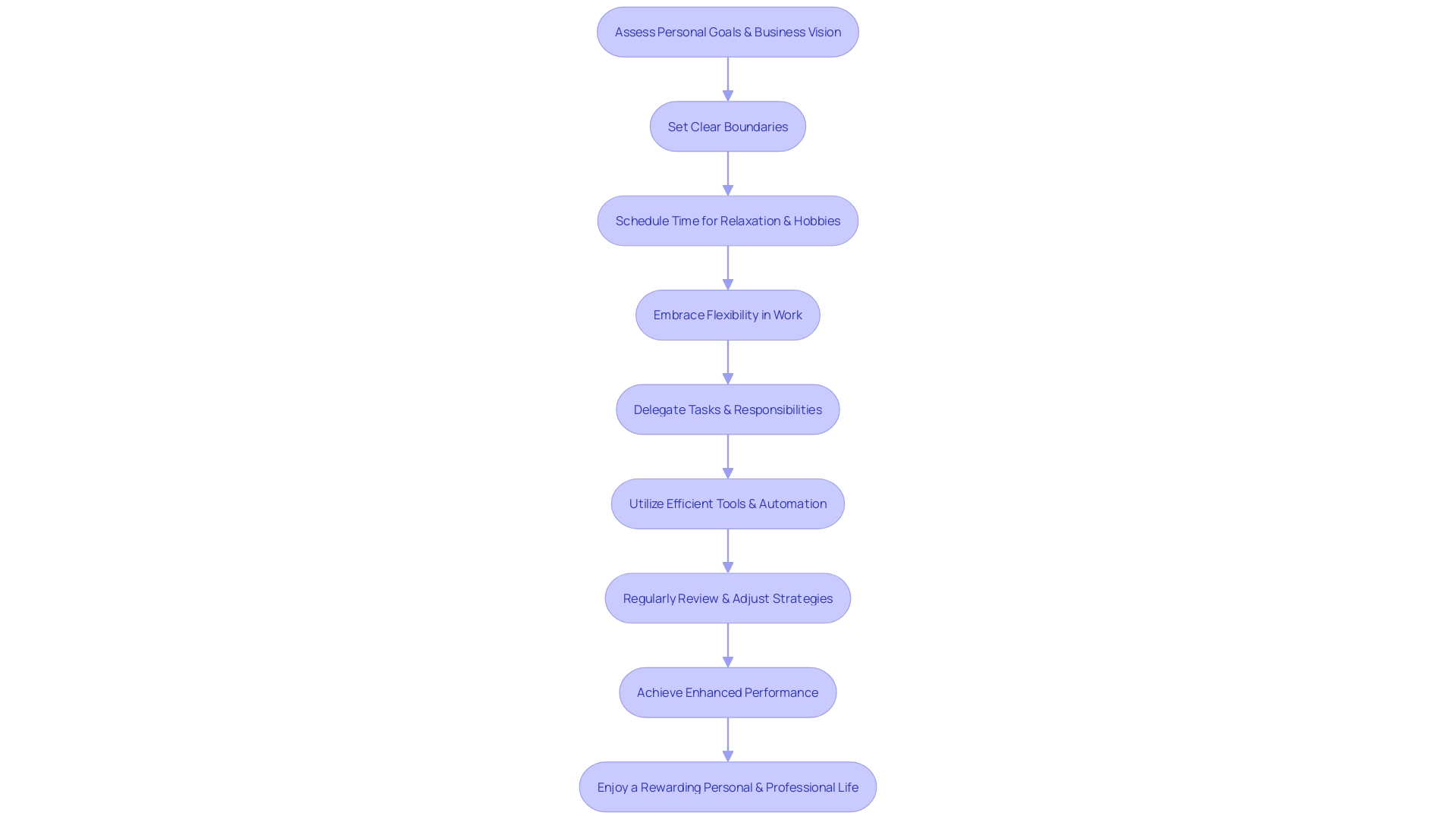
Leveraging Technology for Efficiency
Small entrepreneurs must navigate a plethora of challenges to achieve efficiency and growth. Leveraging technology is a critical strategy for overcoming these hurdles. For instance, adopting digital tools that automate mundane tasks can lead to significant time and cost savings. A robust customer relationship management (CRM) system is vital for effectively managing customer data and enhancing service quality, much like how 'Prix fixe' menus offer a pre-selected, valuable dining experience at a fixed cost, as seen in the culinary world. Similarly, e-commerce platforms are not just a convenience but a necessity for expanding market reach in today's digital age.
It's also crucial to regularly evaluate your technology stack to ensure it aligns with your objectives. For instance, Your Mates Brewery in Australia saved significantly by utilizing specialized software to manage their inventory and scheduling, emphasizing the significance of selecting the appropriate technology to meet specific enterprise requirements.
Furthermore, the environment of financial support for small enterprises is continuously changing, as observed with the accessibility of disaster relief grants and renewable energy grants to aid enterprises during challenging periods and eco-friendly transformations. It's essential to stay informed about such opportunities to secure necessary funding.
Entrepreneurs owning small enterprises should not underestimate the significance of technology in streamlining financial transactions, including invoicing and payroll processes. Cloud-based solutions offer a plethora of options for streamlining these critical activities, enhancing the life-blood of any enterprise—its finances.
As emphasized by industry leaders, continual learning and improvement are the cornerstone of efficiency. Utilizing data visualization tools can provide valuable insights for data-driven decision-making. The Tech.co's Impact of Technology on the Workplace 2024 Report indicates that a majority of enterprises (56%) report high productivity levels, highlighting the positive impact of technology on organizational operations.
In summary, small business owners must embrace technology as a strategic partner in their quest for success. By carefully selecting and integrating digital tools and platforms that align with their goals, they can enhance productivity, improve customer relations, and ensure financial agility in a highly competitive marketplace.

Conclusion
To achieve long-term growth and success, small business owners must understand their customer base, craft an impactful brand, embrace strategic risks, and stay ahead of the competition. By tailoring offerings to meet specific needs, connecting with target audiences, and taking bold steps, small businesses can thrive in today's competitive landscape.
Market research is crucial in gaining a competitive edge. It provides valuable insights that allow small business owners to understand their customer base, focus their efforts, and connect on a deeper level. By designing solutions that address specific problems with high-quality, easy-to-use, and durable products, businesses can stand out from the crowd.
Crafting an impactful brand goes beyond a logo or slogan. It involves fostering expectations, memories, and relationships that influence consumer choices. Small business owners can create a robust brand identity by taking a holistic approach to branding and marketing.
This includes targeted advertising strategies and seizing opportunities on niche websites to engage with a focused audience and drive sales.
Embracing strategic risks can propel businesses forward. By pinpointing their competitive advantage and positioning themselves accordingly, small business owners can not only survive but thrive in a competitive landscape. Taking calculated risks, such as investing life savings into a launch, can set the stage for long-term growth and success.
In conclusion, small business owners can overcome obstacles and achieve long-term growth and success by understanding their customer base, crafting an impactful brand, embracing strategic risks, and staying ahead of the competition. By tailoring offerings, connecting with target audiences, and taking bold steps, small businesses can thrive in today's competitive landscape. Stay focused, adaptable, and willing to take calculated risks to achieve your goals.
Stand out from the competition with our high-quality, easy-to-use, and durable products!




